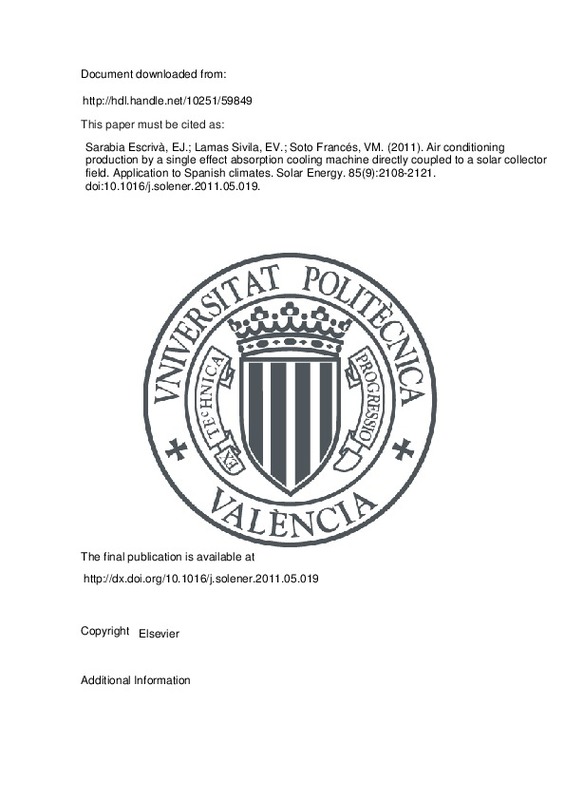JavaScript is disabled for your browser. Some features of this site may not work without it.
Buscar en RiuNet
Listar
Mi cuenta
Estadísticas
Ayuda RiuNet
Admin. UPV
Air conditioning production by a single effect absorption cooling machine directly coupled to a solar collector field. Application to Spanish climates
Mostrar el registro sencillo del ítem
Ficheros en el ítem
| dc.contributor.author | Sarabia Escrivà, Emilio José
|
es_ES |
| dc.contributor.author | Lamas Sivila, Edwin Víctor
|
es_ES |
| dc.contributor.author | Soto Francés, Víctor Manuel
|
es_ES |
| dc.date.accessioned | 2016-01-13T13:41:26Z | |
| dc.date.available | 2016-01-13T13:41:26Z | |
| dc.date.issued | 2011-09 | |
| dc.identifier.issn | 0038-092X | |
| dc.identifier.uri | http://hdl.handle.net/10251/59849 | |
| dc.description.abstract | Due to the increasing energy consumption of air conditioning in buildings and the need to decrease the fossil CO2 emissions to the environment, the interest of using renewable energy sources shows up stronger than ever. We present a general study whose aim is to propose a method to evaluate an upper bound in the potential of solar cooling by using some simplified models. As an example it has been applied to the very diverse climates of Spain. In the paper it has been assumed a direct solar coupling between the solar collector field and a single effect absorption cooling machine, without any intermediate solar storage tank. An equation is obtained that shows the dependence of the generator/solar-collectors equilibrium temperature on basic design parameters of the system (absorption machine-solar collectors). The paper analyzes the effect of these on the total amount of cooling produced along a typical mean year and the peak cooling power. The paper also includes a discussion on how to estimate the values and what is their physical meaning of the parameters which define the behavior of real absorption machines. Finally tables are included for the 12 climates of Spain that can be used as an example of how to make a quick pre-sizing of such direct coupled system. The classification of the Spanish climates is based on general data (average monthly total horizontal solar radiation, average monthly dry temperature, etc.) and the results could be generalized for climates with the same severity. Moreover if hourly weather data is available for any place (like tmy2, bin, epw, etc. files), the procedure can be applied without further changes. | es_ES |
| dc.language | Inglés | es_ES |
| dc.publisher | Elsevier | es_ES |
| dc.relation.ispartof | Solar Energy | es_ES |
| dc.rights | Reserva de todos los derechos | es_ES |
| dc.subject | Solar energy | es_ES |
| dc.subject | Energy efficiency | es_ES |
| dc.subject | Absorption cooling | es_ES |
| dc.subject | Low carbon | es_ES |
| dc.subject.classification | MAQUINAS Y MOTORES TERMICOS | es_ES |
| dc.subject.classification | TERMODINAMICA APLICADA (UPV) | es_ES |
| dc.title | Air conditioning production by a single effect absorption cooling machine directly coupled to a solar collector field. Application to Spanish climates | es_ES |
| dc.type | Artículo | es_ES |
| dc.identifier.doi | 10.1016/j.solener.2011.05.019 | |
| dc.rights.accessRights | Abierto | es_ES |
| dc.contributor.affiliation | Universitat Politècnica de València. Departamento de Termodinámica Aplicada - Departament de Termodinàmica Aplicada | es_ES |
| dc.description.bibliographicCitation | Sarabia Escrivà, EJ.; Lamas Sivila, EV.; Soto Francés, VM. (2011). Air conditioning production by a single effect absorption cooling machine directly coupled to a solar collector field. Application to Spanish climates. Solar Energy. 85(9):2108-2121. doi:10.1016/j.solener.2011.05.019 | es_ES |
| dc.description.accrualMethod | S | es_ES |
| dc.relation.publisherversion | http://dx.doi.org/10.1016/j.solener.2011.05.019 | es_ES |
| dc.description.upvformatpinicio | 2108 | es_ES |
| dc.description.upvformatpfin | 2121 | es_ES |
| dc.type.version | info:eu-repo/semantics/publishedVersion | es_ES |
| dc.description.volume | 85 | es_ES |
| dc.description.issue | 9 | es_ES |
| dc.relation.senia | 208277 | es_ES |







![[Cerrado]](/themes/UPV/images/candado.png)

